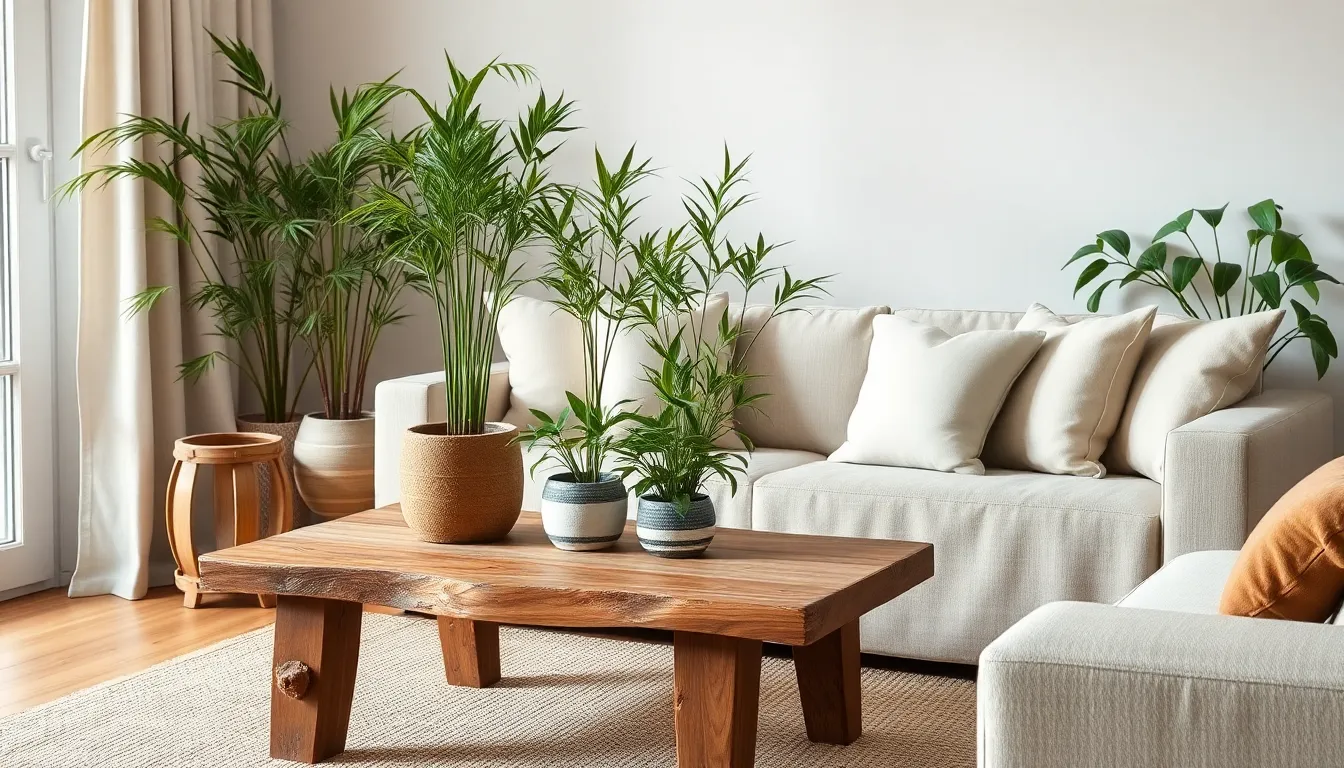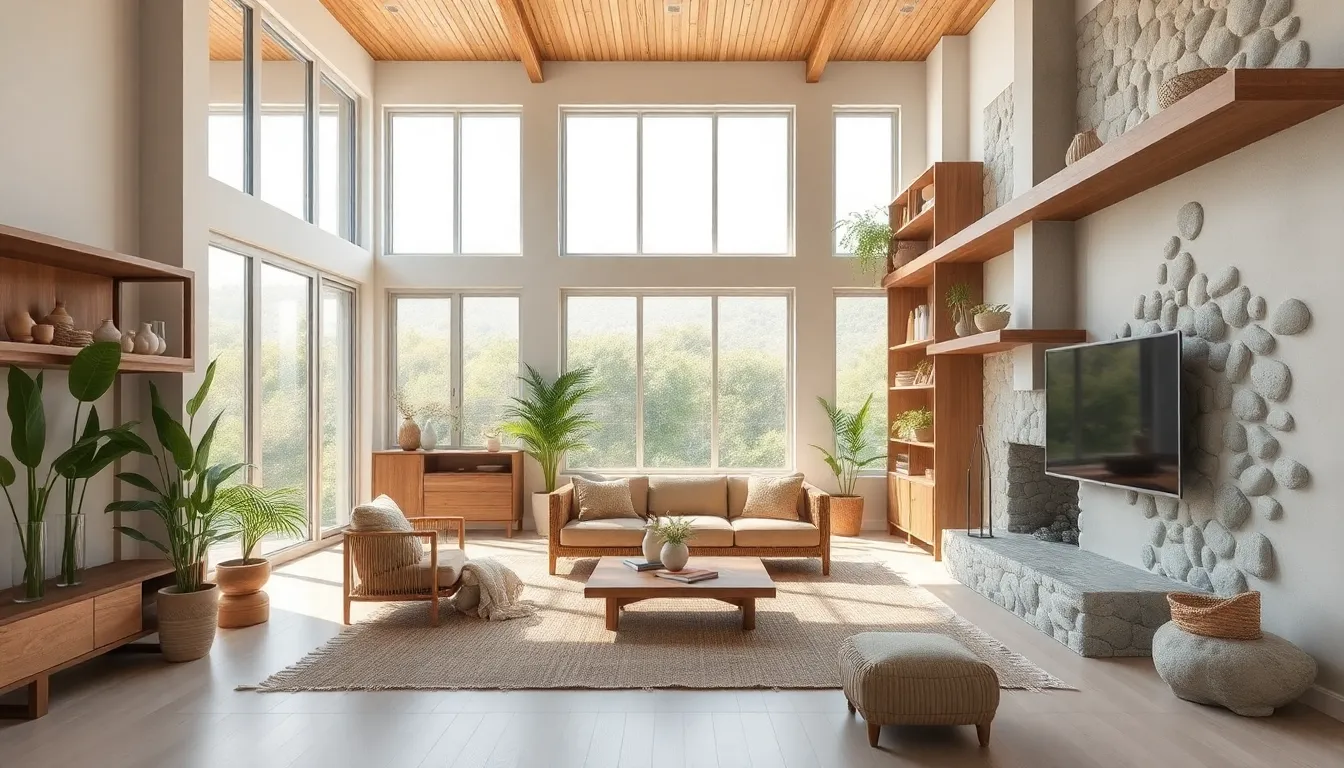Table of Contents
ToggleIn a world where plastic reigns supreme, the charm of natural materials in interiors is like a breath of fresh air—or a whiff of freshly baked bread, if you will. Imagine walking into a space that feels alive, where wood whispers stories of ancient forests and stone hums with the earth’s history. Natural materials bring warmth and authenticity, making any room feel like a cozy hug from Mother Nature herself.
But it’s not just about aesthetics; incorporating natural elements can transform your home into a sanctuary of well-being. Say goodbye to synthetic vibes and hello to a space that feels as good as it looks. So grab your favorite cup of herbal tea, and let’s dive into the delightful world of natural materials that’ll have your interiors singing in harmony with the great outdoors.
Overview Of Natural Materials In Interiors
Natural materials offer a timeless charm in interior design. Wood, stone, and textiles create a warm, inviting atmosphere that resonates deeply with individuals. Enhanced by their organic textures, these materials establish a connection to the outdoors, promoting a calming environment.
Sustainability plays a crucial role in the choice of these materials. Products sourced from renewable resources contribute to eco-friendly design, reducing the ecological footprint of a home. Bamboo, for instance, grows rapidly and serves as an excellent sustainable option.
Health benefits also accompany natural materials. Studies show that aspects such as improved air quality arise from using wooden surfaces, as they help regulate humidity levels. Stone also provides durability and requires minimal maintenance, making it a practical choice.
A variety of options exist when choosing natural materials for interiors. Affordable alternatives to high-end options include reclaimed wood or locally sourced stone. Mix and match different materials to enhance visual interest and create unique combinations.
Color palettes draw inspiration from nature, reflecting earthy tones like greens, browns, and grays. Natural materials can function together to create a cohesive design language throughout a space. Textiles like cotton, linen, and wool provide comfort and warmth and can accentuate the overall aesthetic.
Incorporating natural elements leads to versatile design possibilities, appealing to both modern and traditional styles. Whether it’s a rustic cabin or a contemporary apartment, these materials seamlessly blend into various settings. Making conscious choices about natural materials supports a sustainable lifestyle and elevates home environments.
Benefits Of Using Natural Materials
Natural materials offer various advantages in interior design. Their appeal lies not only in aesthetics but also in significant benefits for sustainability, health, and overall well-being.
Sustainability And Environmental Impact
Sustainable choices in materials minimize environmental footprints. Natural resources, such as bamboo and reclaimed wood, regenerate swiftly and reduce deforestation impacts. These options tend to require less energy during production compared to synthetic materials, making them eco-friendly. Using locally sourced stone further cuts down on transportation emissions, supporting local economies. Homeowners contribute to eco-conscious living by selecting materials that promote sustainability. Each decision to use natural materials can help in resolving pressing environmental issues.
Health Benefits
Natural materials often enhance indoor air quality. Wood, for example, can absorb moisture, helping to maintain humidity levels and reducing the presence of allergens. Stone surfaces contribute durability while providing a sense of stability within living spaces. Textiles like cotton and linen promote comfort in homes, avoiding synthetic alternatives that may emit harmful chemicals. Selecting these materials helps create a healthier environment, promoting well-being. They empower individuals to craft spaces that support both physical and mental health.
Types Of Natural Materials
Natural materials enhance interiors with warmth and authenticity. Key types include wood, stone, bamboo, and natural fibers.
Wood
Wood adds character and warmth to spaces. Varieties like oak and pine offer unique grains and hues that bring depth. Sustainable sourcing, such as reclaimed wood, not only preserves forests but also reduces waste. Homeowners often appreciate wood’s comfort, as it helps regulate humidity and improve indoor air quality. Moreover, wooden surfaces resist allergens, promoting a healthier living environment.
Stone
Stone provides a timeless elegance and robustness. Options like granite and marble offer stunning visuals and durability for countertops and flooring. Locally sourced stone supports regional economies, reducing transportation emissions. Patterns and textures in stone add natural beauty and uniqueness to interiors. As a non-toxic material, stone surfaces contribute to improved air quality, enhancing the overall wellness of a living space.
Bamboo
Bamboo stands out as an eco-friendly alternative to traditional hardwoods. Rapid renewability makes it a sustainable choice for flooring and furniture. The lightweight yet strong composition allows for versatile applications in modern designs. Bamboo’s natural anti-bacterial properties help maintain a healthy indoor atmosphere. Its warm, inviting appearance complements various décor styles effortlessly.
Natural Fibers
Natural fibers such as cotton, linen, and jute offer comfort and style in textiles. These materials breathe well, enhancing airflow and reducing humidity levels. Eco-conscious home decor often features rugs, curtains, and cushions made from these fibers. Textiles made from natural sources lack harmful chemicals, promoting a safer indoor environment. Incorporating natural fibers enriches visual appeal while supporting a sustainable lifestyle.
Incorporating Natural Materials In Interior Design
Utilizing natural materials in interior design enhances aesthetics and promotes well-being. Thoughtful integration of elements like wood and stone creates a harmonious environment.
Techniques For Integration
Consider using reclaimed wood for flooring or accent walls. Scattering stone slabs throughout the space enhances texture and sophistication. Incorporate natural fibers into rugs or curtains to add comfort. Using bamboo to create furniture pieces introduces a modern yet eco-friendly touch. Layering these materials in various forms—like furniture, surfaces, and décor—boosts visual interest. Aligning color palettes with earthy tones establishes a calming atmosphere, while maximizing natural light amplifies the appeal of these materials.
Style Inspirations
Explore Scandinavian design’s minimalist approach, which emphasizes natural materials like light wood. Rustic styles often incorporate reclaimed elements for added character and warmth. Industrial designs pair stone with metal accents for a striking contrast. Coastal themes benefit from driftwood and linen, conjuring a breezy ambiance. Contemporary settings can blend natural materials with sleek lines for a fresh perspective. Combining styles allows for personalized spaces that reflect a commitment to sustainability and comfort.
Conclusion
Embracing natural materials in interior design offers a pathway to create spaces that resonate with warmth and authenticity. These elements not only enhance the aesthetic appeal of a home but also foster a healthier living environment. By integrating sustainable options like reclaimed wood and bamboo, individuals can contribute to eco-friendly practices while enjoying the timeless beauty of nature indoors.
Incorporating these materials allows for a unique blend of style and comfort, reflecting personal tastes and values. As design trends continue to evolve, the enduring charm of natural materials remains a steadfast choice for those seeking to elevate their interiors. Ultimately, choosing natural materials is a commitment to sustainability and well-being, transforming living spaces into true sanctuaries.









